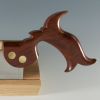I'm looking to try out beeswax on my turnings and surprisingly, the local farms don't sell it. This is what I found. Am I looking at the right product here? Can someone recommend? Richard raffan inspired me to try it out.
https://essentialorganicingredients....BoC48AQAvD_BwE
Edit: also, I see there's yellow and white beeswax available through some vendors. Which and why? Thanks in advance.




 Reply With Quote
Reply With Quote
 .
.


